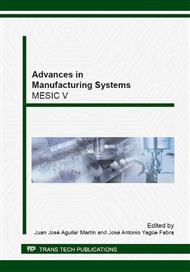p.133
p.139
p.145
p.157
p.163
p.171
p.177
p.183
p.189
Influence of the Friction and the Geometry in Indentation Processes
Abstract:
Nowadays, there are a large variety of Compressive Forming Processes with different typologies and characteristics. These processes look to manufacture workpieces in the manner more efficient and economic possible. In this paper, the indentation process is studied from the point of view of manufacturing. The influence of technological parameters such as friction and shape factor on the process has been studied. The aluminum alloy AA 6082 has been employed in this study due to its good mechanical properties, light weight and its capacity of being recycled. The Finite Element Method (FEM) has been used for the analysis. The indentation process has been studied under axisymmetric conditions. As results, the forces to carry out the indentation process and the contact pressures have been obtained. Finally, it is shown that the forces and the contact pressures do not have a high dependency on the friction between the surfaces of the punch and the workpiece. The other hand, it is displayed that the shape factor has a greater influence on the process, especially the width of the workpiece.
Info:
Periodical:
Pages:
163-168
Citation:
Online since:
June 2014
Authors:
Price:
Сopyright:
© 2014 Trans Tech Publications Ltd. All Rights Reserved
Share:
Citation:


